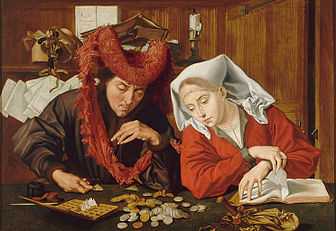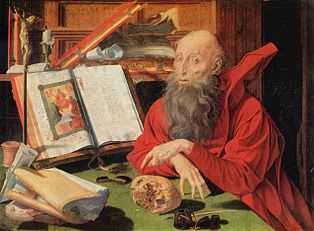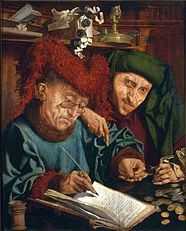Marinus van Reymerswaele
_-_The_Money_Changers_-_Google_Art_Project.jpg)
Marinus Claeszoon van Reymerswaele (c.1490–c.1546) was a Dutch painter.[1] [2]
Biography

_Saint_Jerome_in_his_study.jpg)

Marinus van Reymerswaele received later the name of the city of Reimerswaal, Netherlands, where he was born and where he worked, at least from 1533-1540. In the latter year he moved to Goes, where he died around 1546. He is also named Marinus de Seeu (from Zeeland, a province of the Netherlands). He studied at the University of Leuven (1504) and was trained as a painter in Antwerp (1509). His name is known from a small number of signed panels. A number of other paintings are attributed to Marinus on stylistic grounds. His oeuvre consists of a relatively small numbers of themes only, mostly adapted from Quentin Massys and Albrecht Dürer:
- The moneychanger and his wife
- Two tax collectors
- The lawyer’s office
- Saint Jerome in his study
- The calling of Matthew
A large group of tax collectors are wrongly attributed to Marinus. His themes were popular in the sixteenth century and his paintings copied many times.
Signed work
- Antwerp, Royal Museum of Fine Arts
- Saint Jerome in his study (1541)
- Dresden, Gemäldegalerie Alte Meister
- The moneychanger and his wife (1541)
- El Escorial, Escorial
- The moneychanger and his wife (1538)
- Florence, Bargello
- The moneychanger and his wife (1540)
- Kopenhagen, Statens Museum for Kunst
- The moneychanger and his wife (1540)
- Madrid, Museo del Prado
- Saint Jerome in his study (most likely: 1541)
- The moneychanger and his wife (1539)
- Saint Jerome in his study (1541)
- München, Alte Pinakothek
- The lawyer’s office (1542)
- The moneychanger and his wife (1538)
- New Orleans, New Orleans Museum of Art
- The lawyer’s office (1545)
Other work
- Douai, Musee de la Chartreuse
- Saint Jerome in his study
- Maastricht, Bonnefanten Museum
- Saint Jerome in his study (ca. 1541)
- Vienna, Kunsthistorisches Museum
- Saint Jerome in his study
- The Unjust Steward
- Antwerpen, Koninklijk Museum voor Schone Kunsten
- Two tax collectors
- London, National Gallery
- Two tax collectors (ca. 1540)
- Paris, Louvre
- Two tax collectors (ca. 1540)
- Saint Petersburg, Hermitage
- Two tax collectors
- Warsaw, Muzeum Narodowe
- Two tax collectors
- Naples, Palazzo Reale di Capodimonte
- "Two tax collectors"
- Ghent, Museum voor Schone Kunsten
- The Calling of Matthew
- Private collection
- The Calling of Matthew (2x)
- Madrid, Museo Thyssen-Bornemisza
- The Calling of Matthew
- Madrid, Prado Museum
- Maria lactans
- Funchal, Museu de Arte Sacra do Funchal
- Saint Jerome
Gallery
- Selected works
-

The moneychanger and his wife. (c. 1538)
-

Two tax collectors (c. 1540), National Gallery, London
-

Saint Jerome in his study (1541), Museo del Prado, Madrid
-

Two tax collectors
References
- ↑ [Max J. Friedländer, Early Netherlandish Painting, Leiden 1975, deel XII pp. 40-3 en 106-8]
- ↑ [Adri Mackor, 'Marinus van Reymerswale: Painter, Lawyer and Iconoclast?', Oud Holland 109 (1995) pp. 191-200]
External links
| Wikimedia Commons has media related to Marinus van Reymerswale. |
|